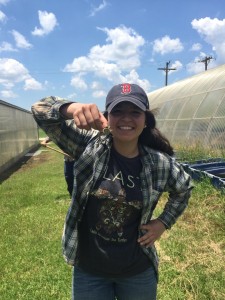My name is Cynthia Sias and this summer I am engaging in a weed science research lab under the direction of Texas A&M Professor, Dr. Muthu Bagavathiannan (Dr. Muthu). Over the course of nine weeks I will be working with Dr. Muthu’s eight graduate students, each studying a different area of weed science and responsible for several projects. My time here at A&M will mostly be spent with two of his graduate students, Tabby Liu and Blake Young.
These first couple of weeks I was able to meet the team and began helping with Tabby’s research plots. Her biggest project going on for the bulk of her summer is a trial that is being held at the Eagle Lake Rice Research station in Eagle Lake, Texas. This is a common garden study that has four replications focused on differences in growth of 30 different barnyard grass populations that have been collected from 30 different sites all across the state of Texas. This part of the study is going to last about three months including the entirety of the summer, and in the end the 30 different populations will be evaluated to compare for differences in growth and structure. Barnyard grass is a weed that is an annual problem for not only rice producers but also for corn, soybean, and potato producers among many others. Some methods used for suppressing this weed upon germination include cultivation and herbicide use and many times both methods are used together. So far, after transplanting the barnyard grass to a field where rice was planted as protection rows, there is evident differences in germination rates as well as the growth structure that is varying across the different samples. Some samples have shown more horizontal elongation whereas other are more vertically elongated. These different physiologies might have an impact on the way that farmers take action when trying to control for the weed. Another important aspect of this study also surrounds checking these different populations for resistance to commonly used herbicides. Increasing weed resistance to herbicides is becoming an increasing problem, not only for rice producers in Texas, but for farmers in general. If an herbicide is used year after year on the same crop, weeds become immune to it and eventually the herbicide is no longer efficient when controlling for weeds in a production field.
A second experiment that is also taking place at the same research center is a smaller study that is centered on understanding emergence rates of the Nealley’s Sprangletop weed which is also becoming an increasing problem for rice producers in Texas. This study involved setting a quadrat in the ground and broadcasting the seed, replicating seven times. Tabby then returns to the research station every week to check germination rates and growth patterns. The main purpose of this study is to evaluate germination in a controlled environment to evaluate how much of a potential problem Nealley’s Sprangletop may become in future years. Studies like this can provide information about rates of emergence that future generations can expect on a production field as well as potential ways to control for emergence. In addition, soil sampling can provide information about seed beds and their contents found in a rice field.
For the next blog I will be sharing what I learned while working with Blake in his Johnson grass trials!

Not all the work is performed on the field. While working in the greenhouse I learned about small frogs that like wet and humid environments. There is more to agriculture than just the crops!

